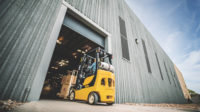In the game of Jenga, players have to be nimble in order to keep the wooden tower from collapsing. In a beverage warehouse, forklift operators must possess this same quality for a more serious purpose — transporting product without causing damage. And just like Jenga, in the game of material handling, every move counts.
“With as much as 70 percent of the cost of operating a forklift tied to operator productivity, forklift features that allow operators to move loads faster and safer not only make the job easier for operators but also make the whole operation more productive,” says Andy Smith, senior marketing product manager for Crown Equipment Corp., New Bremen, Ohio.
For instance, Crown added new features to its Crown SC 5200 Series of sit-down counterbalanced forklifts earlier this year that enable faster travel speeds to increase productivity; optional fingertip and joystick hydraulic control options that optimize operator comfort and performance; and an optional two-stage lift mast that delivers flexibility in multiple applications, he says.
Forklift attachments, such as layer pickers and single-double pallet handlers, also can help improve productivity. Layer picking attachments enable operators to form mixed pallets, which is an increasing trend in the beverage industry, according to experts. Tygard Machine & Manufacturing, Washington, Pa., offers the Tygard Claw four-way pressure-sensitive layer-picking device that can attach to any brand of forklift, the company says. It is able to reduce warehouse labor by as much as 40 percent, reduce worker injuries, increase order accuracy, decrease order-receiving process times, and reduce the amount of warehouse space needed for order fulfillment, it adds. Single-double pallet handler attachments also are commonly used in the beverage industry, says Cesar Jimenez, national product planning and training manager for Toyota Material Handling U.S.A. Inc., Irvine, Calif. These attachments allow operators to handle two pallets at a time, which helps operators load the trailers in a shorter period of time, he explains.
“Handling multiple loads will also continue to be a popular method of transport to increase productivity, whether in the form of low-lift walkie rider trucks with extended fork lengths that can transport up to three ground-level pallets or via multiple-load handling attachments used on traditional sit-down lift trucks,” says Jeff Bowles, product line manager for Mitsubishi Caterpillar Forklift America Inc. (MCFA), Houston.
MCFA recently introduced a line of high-capacity, Class 1 electric four-wheel models that were designed with soft-ride, solid, pneumatic tires to improve shock absorption, he says. The trucks have a wider footprint than traditional sit-down warehouse trucks, which is particularly beneficial for secure load handling when operators are transporting multiple pallets side-by-side, he explains.
Managing space
Industry trends such as SKU proliferation have made order picking a bit more challenging, says Jim Hess, national accounts manager for The Raymond Corp., Greene, N.Y.
“Typically, bulk stacking has been common in the beverage industry, and it’s the best way to achieve storage density because there are very few aisles,” he says. “They’ll stack six, eight, 10 deep of the same product, and that storage method has worked very well in the past. But with the increased number of SKUs that they’re handling now, selectivity might be an issue today or in the near future. Basically, getting to that product you need to fill an order may require moving many loads in front of it, and that requires extra labor, and that affects that facility’s productivity.”
This issue is becoming more common as distributors are delivering product more frequently to their customers, he says.
If space is an issue within a warehouse, deep reach trucks are able to reach two loads back in the racking, which improves space efficiency, Hess says. Swing reach trucks also can help save space by taking a typical 10-foot aisle down to as little as 6 feet, he adds.
MCFA’s new Class 3 center rider truck with an elevating platform enables operators to reach low- and high-level SKU locations in the same picking area, Bowles says. By using the truck for low-level order picking, the second pick level can double the amount of SKU locations in the same area, he explains.
“This is a very important advantage in beverage applications where order picking is done primarily at floor level,” Bowles says.
“Space utilization will also continue to be a critical aspect of successful, expanding beverage operations,” Bowles continues. “For example, there is now an increasing usage in the beverage industry of specialized racking, which combines high-density load storage with simultaneous, multiple-load put-away and retrieval in the racking.”
Operator monitors
Technology also plays a role in many machines to keep the process as productive as possible. For instance, earlier this year, Yale Materials Handling Corp. introduced the Yale Vision wireless asset management system, which offers a variety of tracking capabilities, operator access control and idle shutdown control, says Bill Pfleger, president of Yale distribution for the Greenville, N.C.-based company. By monitoring forklift activity, such as seat belt violations, speed alerts and costs, the operations can be optimized for greater productivity and efficiency, he notes. The software also can send out automatic emails when certain faults or impacts occur, which can improve the information available when reviewing incidents, he adds.
“For operator access, Yale Vision knows who is operating the equipment and can keep untrained personnel from accessing or operating a piece of equipment,” Pfleger says. “This increased operator accountability can improve driving behaviors and reduce damage or repair needs to the equipment.
“The idle shutdown feature will power off equipment following a pre-identified amount of time if the equipment is tracked as idling or unattended, reducing excess fuel costs and preventing running equipment from being left unattended,” Pfleger continues.
Similarly, The Raymond Corp. offers its iWarehouse and iBattery fleet optimization products, which measure productivity, conduct analyses, track maintenance, and offer paperless Occupational Safety and Health Administration (OSHA) daily checklists, which can save approximately 10 minutes a day, Hess says. The software also monitors forklift impacts to help reduce product, rack and truck damage, he adds.
“It also helps the manager,” Hess says. “It gives them the tools in real time to maximize their usage of the trucks, [select the] right-size fleet, and this all helps them drive costs out of the operations.”
A comfortable fit
When it comes to productivity, ergonomics also play an important role, Yale’s Pfleger says.
“We are seeing a strong emphasis on operator ergonomics and the understanding that this is more and more becoming a driver for productivity,” he says. “The question is: How can the design and ergonomics of the lift truck enable the operator to be as productive in hour one as the last hour of the shift? It’s easy — by providing the most comfortable experience for the operator by offering customized features, adjustable controls, and a similar ergonomic interface to other models within a fleet.”
For instance, the company recently launched Yale iSi Technology, which is a control system that provides a similar interface across its line of warehouse trucks. This helps to optimize unit and operator efficiency to match application requirements, resulting in lower overall operating costs for the customer, Pfleger says.
Additionally, MCFA introduced electric power steering systems for its new generations of Class 1 and 3 electric trucks, which previously utilized hydraulic or manual steering systems, Bowles says. As a result, operators can benefit from less fatigue and a more precise, quiet steering function, he says. Its forklifts also offer an optional ProPick feature, which enables the operator to control the vehicle from the side of the truck while they pick orders, he explains. This increases their overall productivity by eliminating the need to use the truck’s tiller handle to move between pick locations, he adds.
“Improvements and innovations to assist operators in terms of ergonomics will also continue to be at the forefront of new lift truck designs,” Bowles says.
Fueling demand
Beyond technology and ergonomics, many food and beverage companies are looking into converting from machines powered by internal combustion engines to ones powered by industrial batteries, Toyota’s Jimenez says. When the company switched from direct current (DC) to alternating current (AC) motors, 60 percent of lift trucks were gas-powered and 40 percent were electric, he says. Today, 65 percent are electric and 35 percent are gas-powered, he adds. Benefits of electric lift trucks include performance in wet or cold environments, easy maneuverability, ease of pallet entry or exit, energy efficiency, ease of maintenance, durability and reliability, he notes.
A drawback to electric forklifts, however, is that they do not produce any engine noise, says Kevin Rising, national accounts manager for UniCarriers America Corp., Marengo, Ill. Thus, facilities need to make sure to utilize all of the safety features available, he says. For example, a new safety innovation is a blue light that trails behind a forklift to draw attention to it, he notes.
With electric forklifts, 5 percent of the cost of the vehicle will go toward energy to charge the battery, according to The Raymond Corp.’s Hess. Therefore, chargers have been taken to the next level.
“Today’s technology on the chargers has come a long way, where there are high-frequency chargers and then there are opportunity chargers,” UniCarriers’ Rising says. High-frequency chargers operate utilizing more power and are clean and efficient, he says. Opportunity chargers, on the other hand, enable the operator to charge the battery at convenient times throughout the day, which enables greater run time on a unit, he adds.
The industry also has shown greater interest in fuel cell and hybrid vehicles, Toyota’s Jimenez says. “Hybrids offer great potential for those wanting to save on fuel but need an [internal combustion engine] for their specific application,” he says. “It will be the product that closes the gap between electric and [internal combustion] lift trucks.”
In the future, equipment manufacturers expect automation to become more prevalent within warehouses.
“Beverage companies rely on a combination of high productivity and cost containment,” MCFA’s Bowles says. “To manage both of these aspects, they will continue to pursue automated practices in certain areas of their facilities, including product storage and transport. In facilities of sufficient size, [automated guided vehicles] (AGVs), advanced conveyor systems and automated cranes will be used for product transport and storage.”







